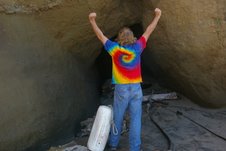
 Story by John Vonderlin
Story by John Vonderlin
Email John ([email protected]\
Pioneer Sawmills
Hi June,
A while ago I posted some excerpts from the old history books that seemed to lean towards Dennis Martin constructing the first sawmill in San Mateo County, rather then Charles Brown, who is credited by many. Both are credited as possibilities on the plaque on Portola Road, commemorating the first San Mateo sawmill. One account I shared even had somebody else building the first mill on Brown’s property and leasing it from him. Well, here’s an article from the “Call,” that seems to add another possibility.
Bill Pease (Peace?) is acknowledged in the other accounts as being the first sawyer, but only as a hands-on kind of guy, without a sawmill. This article seems to state otherwise. It is from the March 1st, 1889, issue of the “Call.” Enjoy. John
P.S. You’ll notice this came up on an “Isaac Graham” Search. He has a lot of connections to interesting people, and events, sometimes not so pleasant connections, but often colorful.
PIONEER SAW-MILLS. Early Methods of Making Timber of California Redwood.
Pacific Coast Wood and Iron
In the early history of California all the lumber required for the use of its inhabitants, not a great deal, was gotten out with the whip saw and tbe axe, the thinner boards being manufactured with the saw, while the planks, beams, etc., were first split out and afterward hewn into the desired shape. As most of the lumber then used was made from the redwood, the manufacture of the coarsest kinds was an easy matter, owing to the facility with which that timber rives. The first sawmill in the country was put up at Santa Cruz by Isaac Graham, in 1843. It was driven by water, and though of limited capacity, was able to meet all the requirements made upon it. Such a contrivance for cutting lumber greatly astonished the natives, who had never seen anything of the kind before. Though all talked about “la maquina” and wondered at its performance, it excited neither jealousy nor opposition, the. ease-loving Californians being only too glad to avoid the laborious task ol getting out lumber by the old methods. The extra wages paid lumbermen were not with them so much an object as a decent excuse for shirking hard work altogether. And so this pioneer sawmill proved a good thing all round: Isaac Graham made money out of it, while los wvaqueros, through its operations, were relieved from tbe irksome toil of making lumber with the whip-saw, the beetle and tbe axe.
In the fall of 1845, Captain Stephen Smith, of Baltimore, put up a sawmill on Bodega Bay, this being the second one erected in California. Captain Smith had been on this Coast before, having arrived here first in the month of May, 1841, bringing his vessel around Cape Horn. Visiting Bodega Bay at that time, and noticing the fine timber growing in the vicinity, it occurred to him that a good opening offered there for cutting lumber for the use of the Russian settlement near by, for the settlers in Sonoma Valley, and for the San Francisco and other markets further south. Returning to Baltimore by the Isthmus of Panama, he brought out on his return trip machinery for a steam sawmill, as well as a steam flouring mill, both of which were set up on the shores of Bodega Bay, the latter being used for grinding the wheat raised at the Russian settlement at Fort Ross. In connection with this enterprise, Captain Smith obtained from the Mexican Government a grant for eight leagues of land lying adjacent to the bay, much of it well timbered with redwood. A little later in the same year. General Vallejo built a sawmill in the redwoods six miles above the town of Sonoma. A good deal of lumber was made here, the occupation of the country a year later by the Americans greatly increasing the demand for this article. The following year, James Peace (sp?) built a sawmill at a point about twenty miles south of San Francisco. It was located in the redwoods in the southern part of what is now San Mateo county. Then followed the Sutter-Marshall mill, erected in the fall of 1847, on the South Fork of the American river, where stands the town of Coloma, or rather, where it did stand, for it is now nearly all washed away…..
